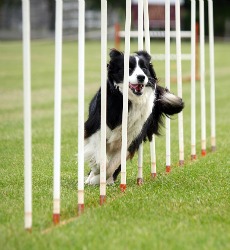Update on Exercise-Induced Collapse and Border Collie Collapse
In 2008, the AKC Canine Health Foundation reported on the ground-breaking discovery of the genetic mutation associated with Exercise Induced Collapse in the Labrador Retriever. Since then thousands of dogs have been tested for the mutation using blood samples submitted to the University of Minnesota Veterinary Diagnostic Laboratory.
The full name for the condition is d-EIC (DNM1-associated exercise-induced collapse) as it is due to a recessive, likely causative, mutation in the dynamin 1 (DNM1) gene  in symptomatic dogs. The DNM1 mutation is also present at high frequency in Chesapeake Bay and Curly-Coated Retrievers, and at low frequency in Pembroke Welsh Corgis. However, the DNM1 mutation was not found in a random sample of 151 Border Collies, and no Border Collies submitted because of a collapse phenotype (23 dogs) had the mutant DNM1 allele.
in symptomatic dogs. The DNM1 mutation is also present at high frequency in Chesapeake Bay and Curly-Coated Retrievers, and at low frequency in Pembroke Welsh Corgis. However, the DNM1 mutation was not found in a random sample of 151 Border Collies, and no Border Collies submitted because of a collapse phenotype (23 dogs) had the mutant DNM1 allele.
Thus, it is likely that Border Collie Collapse (BCC) has a novel genetic basis. With those data in hand, the Mickelson laboratory initiated a project with funding from the AKC Canine Health Foundation to begin sample collections to investigate this hypothesis They now have sufficient samples with which to perform an initial whole genome association analysis.
Independently of the project funded by CHF, Dr. Taylor and colleagues at the University of Saskatchewan have completed pre- and post-exercise evaluation of normal Border Collies chasing a ball, normal Border Collies herding sheep, and 10 sheep-herding or ball-chasing dogs with BCC. These studies involve complete muscular, metabolic and cardiac evaluation of affected dogs in order to eliminate other causes of exercise intolerance, and were designed to enable the investigators to be confident in the diagnosis of BCC and the clinical features of BCC episodes, as required to establish reliable phenotypic descriptions for a genetic study.
The results were striking. Routine laboratory evaluations of dogs with BCC are normal at rest and negative for circulating acetylcholine receptor antibodies expected with the autoimmune disease acquired myasthenia gravis. Furthermore, post- exercise blood lactate concentrations, serum creatine kinase, and muscle biopsies were normal in BCC dogs, eliminating common metabolic disorders and making a mitochondrial myopathy (a type of neuromuscular disease) unlikely. Of perhaps equal importance was the establishment of reference values in normal exercising Border Collies in order to interpret potential changes that occur with exercise in dogs with BCC. With these reference values in place, it appears that the hyperthermia (elevated body temperature) and laboratory “abnormalities” identified after exercise in dogs with BCC are not different from what is seen in normal exercise tolerant Border Collies or Labrador Retrievers performing the same exercise. Collapsing Border Collies from sheep-herding and ball-chasing lines have similar clinical signs and laboratory findings.
Dr. Mickelson’s Interpretations of the Results:
- BCC is likely a unique episodic seizure disorder that can occur in sheep-herding or ball-chasing activity.
- Parents, littermates and half-siblings of dogs with BCC are often affected, which, with the apparent clustering within the breed, supports a heritable basis.
- A genome wide association study should be conducted to map chromosomal loci contributing to BCC.
Related Articles
Help Future Generations of Dogs
Participate in canine health research by providing samples or by enrolling in a clinical trial. Samples are needed from healthy dogs and dogs affected by specific diseases.



